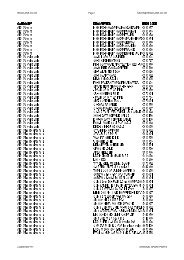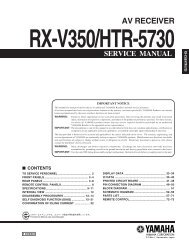(l193sab-al**t) l173sa (l173sab-al**a) l173st ... - MobRepair.ru
(l193sab-al**t) l173sa (l173sab-al**a) l173st ... - MobRepair.ru
(l193sab-al**t) l173sa (l173sab-al**a) l173st ... - MobRepair.ru
You also want an ePaper? Increase the reach of your titles
YUMPU automatically turns print PDFs into web optimized ePapers that Google loves.
General Soldering Guidelines<br />
1. Use a grounded-tip, low-wattage soldering iron and<br />
appropriate tip size and shape that will maintain tip<br />
temperature within the range or 500。F to 600。F.<br />
2. Use an appropriate gauge of RMA resin-core solder<br />
composed of 60 parts tin/40 parts lead.<br />
3. Keep the soldering iron tip clean and well tinned.<br />
4. Thoroughly clean the surfaces to be soldered. Use a<br />
mall wire-bristle (0.5 inch, or 1.25cm) b<strong>ru</strong>sh with a<br />
metal handle.<br />
Do not use freon-propelled spray-on cleaners.<br />
5. Use the following unsoldering technique<br />
a. Allow the soldering iron tip to reach normal<br />
temperature.<br />
(500。F to 600。F)<br />
b. Heat the component lead until the solder melts.<br />
c. Quickly draw the melted solder with an anti-static,<br />
suction-type solder removal device or with solder<br />
braid.<br />
CAUTION: Work quickly to avoid overheating the<br />
circuitboard printed foil.<br />
6. Use the following soldering technique.<br />
a. Allow the soldering iron tip to reach a normal<br />
temperature (500。F to 600。F)<br />
b. First, hold the soldering iron tip and solder the strand<br />
against the component lead until the solder melts.<br />
c. Quickly move the soldering iron tip to the junction of<br />
the component lead and the printed circuit foil, and<br />
hold it there only until the solder flows onto and<br />
around both the component lead and the foil.<br />
CAUTION: Work quickly to avoid overheating the<br />
circuit board printed foil.<br />
d. Closely inspect the solder area and remove any<br />
excess or splashed solder with a small wire-bristle<br />
b<strong>ru</strong>sh.<br />
IC Remove/Replacement<br />
Some chassis circuit boards have slotted holes (oblong)<br />
through which the IC leads are inserted and then bent flat<br />
against the circuit foil. When holes are the slotted type,<br />
the following technique should be used to remove and<br />
replace the IC. When working with boards using the<br />
familiar round hole, use the standard technique as<br />
outlined in paragraphs 5 and 6 above.<br />
Removal<br />
1. Desolder and straighten each IC lead in one operation<br />
by gently prying up on the lead with the soldering iron<br />
tip as the solder melts.<br />
2. Draw away the melted solder with an anti-static<br />
suction-type solder removal device (or with solder<br />
braid) before removing the IC.<br />
- 6 -<br />
Replacement<br />
1. Carefully insert the replacement IC in the circuit board.<br />
2. Carefully bend each IC lead against the circuit foil pad<br />
and solder it.<br />
3. Clean the soldered areas with a small wire-bristle<br />
b<strong>ru</strong>sh. (It is not necessary to reapply acrylic coating to<br />
the areas).<br />
"Small-Signal" Discrete Transistor<br />
Removal/Replacement<br />
1. Remove the defective transistor by clipping its leads as<br />
close as possible to the component body.<br />
2. Bend into a "U" shape the end of each of three leads<br />
remaining on the circuit board.<br />
3. Bend into a "U" shape the replacement transistor leads.<br />
4. Connect the replacement transistor leads to the<br />
corresponding leads extending from the circuit board<br />
and crimp the "U" with long nose pliers to insure metal<br />
to metal contact then solder each connection.<br />
Power Output, Transistor Device<br />
Removal/Replacement<br />
1. Heat and remove all solder from around the transistor<br />
leads.<br />
2. Remove the heat sink mounting screw (if so equipped).<br />
3. Carefully remove the transistor from the heat sink of the<br />
circuit board.<br />
4. Insert new transistor in the circuit board.<br />
5. Solder each transistor lead, and clip off excess lead.<br />
6. Replace heat sink.<br />
Diode Removal/Replacement<br />
1. Remove defective diode by clipping its leads as close<br />
as possible to diode body.<br />
2. Bend the two remaining leads perpendicular y to the<br />
circuit board.<br />
3. Observing diode polarity, wrap each lead of the new<br />
diode around the corresponding lead on the circuit<br />
board.<br />
4. Securely crimp each connection and solder it.<br />
5. Inspect (on the circuit board copper side) the solder<br />
joints of the two "original" leads. If they are not shiny,<br />
reheat them and if necessary, apply additional solder.<br />
Fuse and Conventional Resistor<br />
Removal/Replacement<br />
1. Clip each fuse or resistor lead at top of the circuit board<br />
hollow stake.<br />
2. Securely crimp the leads of replacement component<br />
around notch at stake top.<br />
3. Solder the connections.<br />
CAUTION: Maintain original spacing between the<br />
replaced component and adjacent components and the<br />
circuit board to prevent excessive component<br />
temperatures.






